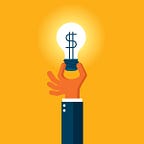The greenback
How important is the US dollar for companies and the world economy?
Following the 2008 financial crisis, currencies like the Japanese Yen or the US Dollar have consolidated themselves as “safe havens” in times of turmoil and appreciated in value relative to other currencies as a result of this. The dollar plays a key role in the world economy. We have to look no further than during the Covid-19 shutdown, where the Fed was forced to extend $65bn worth of swap lines with other Central Banks as the demand for the greenback heated up in a rapid flight for safety that sunk markets further than 30%.
The dollar’s strength and pivotal role in global financial systems comes from its fundamentals. It is a stable currency, it is highly liquid and widely accepted worldwide. Its network effects are phenomenal — not only is it backed by the largest economy in the world but several countries draw down credit lines in dollars. Of course, this plays against them when the greenback appreciates and they see their debt explode in real value terms in comparison to their home currency, meaning their currency can repay less and less over time. Argentina is a clear example of a country that has bitten more US$ debt that it can chew. The economic downturn and deflationary pressures Emerging Market (EM) economies experience translates into their debt exploding in real value. This has cooked up the perfect recipe where the brunt of Argentina’s $65bn of foreign debt is slowly leading the country into its ninth default.
From a company specific level, EM firms can have their costs fixed in U.S. dollars but get their revenues in a local currency. As the dollar rises, so do input costs, while revenue generated from sales stagnates. This increase in funding costs (unless they’ve hedged their currency exposure) leads to financial difficulties moving forward.
The following chart from the FT goes to show the point, with over $105bn owed only in 2020 from a number of Emerging Markets which are often characterised by unstable political environments, sharp currency fluctuations and dependency on a few export oriented sectors.
Additionally, as the EU, Nordic countries or Japan (and New Zealand and the UK are touting them) have taken on negative interest rates, Powell’s stance to not bringing rates down below zero means the US$ becomes more attractive to hold. This is another factor supportive of the currency. A strong currency has a variety of ramifications. Unlike EU banks where negative rates have battered loan profitability and reduced their incentive to lend, their US counterparts are able to generate interest income and come out with more robust balance sheets. Nonetheless, it’s true that when companies bring revenue from abroad it is seen reduced by the strong dollar but this should be hedged as a cost based strategy by MNCs. Also, a strong currency may decrease the number of exports and increase the number of imports as the currency’s purchasing power is greater. Keeping any possible effects to a country’s balance of payments in check is critical.
To finalize, an interesting extract I recently read regarding the strength of the US dollar narrated the following “policymakers have clung to trade-oriented growth even as globalization slowed. That contributed to low economic growth, which led to excess savings (think of the famous Asia savings glut). These excess savings get recycled into “safe” and typically U.S.-dollar denominated financial assets, which boosts the value of the dollar (most of the time). That then pressures the global economy in a way that minimizes growth, and the cycle begins all over again” (Bloomberg Newsletter).
Tying this back to what I mentioned in the first paragraph, it seems to be that the dominant position of the US dollar shapes the movement of capital and investment decisions of individuals. The inherent unpredictability of economic events that threaten global financial and political stability (US-China Relations, EU breakdown, Brexit, HK protests, pandemics, OPEC disagreements) means that dollar assets and the USA’s financial markets seems highly attractive to the public, pushing the greenback’s value up in a cycle that never seems to end. Will there be any other currency that breaks this cycle mentioned in the extract? We will have to look at the strategic moves economies like China or Japan make.
Thank you for reading!
IO
